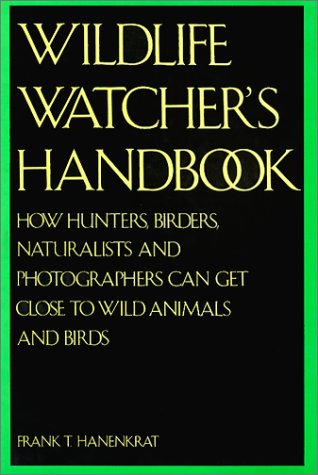Wildlife Watcher's Handbook - Hardcover

"synopsis" may belong to another edition of this title.
A blind, however, creates a different situation. Once the photographer conceals himself inside, the animal can no longer see a human presence. It may respond to human sounds or smells, but these stimuli seem to be perceived by the animal as far less dangerous when a corresponding visual stimulus is absent. Still, some animals may be afraid of the blind itself, though others may not. I put up a portable blind near a small pond in a marsh at the Virginia coast to photograph wading birds, and had scarcely got inside before a belted kingfisher and later an immature black-crowned night heron adopted the blind for a perch; but great egrets who used the pond as a feeding ground would only circle overhead and fly away, obviously reluctant to land at a favorite spot because they feared the blind. Again, I've seen deer walk cautiously up to a blind and stick its nose against it, obviously curious, but another deer skittishly whiff it from a distance of twenty yards and then turn tail and run. Indeed, unless the blind is placed near a nest or den where family are being reared, an animal's responses to it are so unpredictable that most photographers quickly learn that they cannot know what to expect.
Probably most wildlife photography employing blinds is done at nests or dens containing young, for this is the time when animal family centers the most activity in a small area. If relatively large mammals are being photographed--say a coyote family or a cougar mother and cubs--the blind will usually have to be situated some distance away and shooting conducted with a long telephoto lens because the animals are likely to be suspicious and fearful of the human scent around the blind. Large shy birds, such as some hawks and owls, are also likely to be disturbed by the mere presence of a blind if it is located too close to the nest. Most smaller mammals and birds, however, will accept the presence of a blind fairly close to the den or nest if it is properly introduced.
There are two ways to introduce a blind. One technique is to select the blind site and place on it a moderately small object such as a weighted cardboard box or a plastic pail. Many animals will apparently accept a small object much more readily than blind; if the smaller object is accepted in a given spot, a day or so later it can be removed and replaced by a blind with very little disturbance to the animal. Another, more traditional technique is to move the blind into position in stages over a period of days. Three days is a standard time. On the first day the blind is erected some distance from the chosen site, placed in such a way that the animals will not fail to notice it but will not feel intimidated by its presence. The blind is left unoccupied. On the second day the blind is moved halfway to the chosen site and again left unoccupied, and on the third day it is placed in final position.
"About this title" may belong to another edition of this title.
- PublisherWinchester Press
- Publication date1977
- ISBN 10 0876912455
- ISBN 13 9780876912454
- BindingHardcover
- Edition number2
- Number of pages241
Buy New
Learn more about this copy
Shipping:
US$ 5.13
Within U.S.A.
Top Search Results from the AbeBooks Marketplace
WILDLIFE WATCHER'S HANDBOOK
Book Description Condition: New. New. In shrink wrap. Looks like an interesting title! 1.35. Seller Inventory # Q-0876912455

